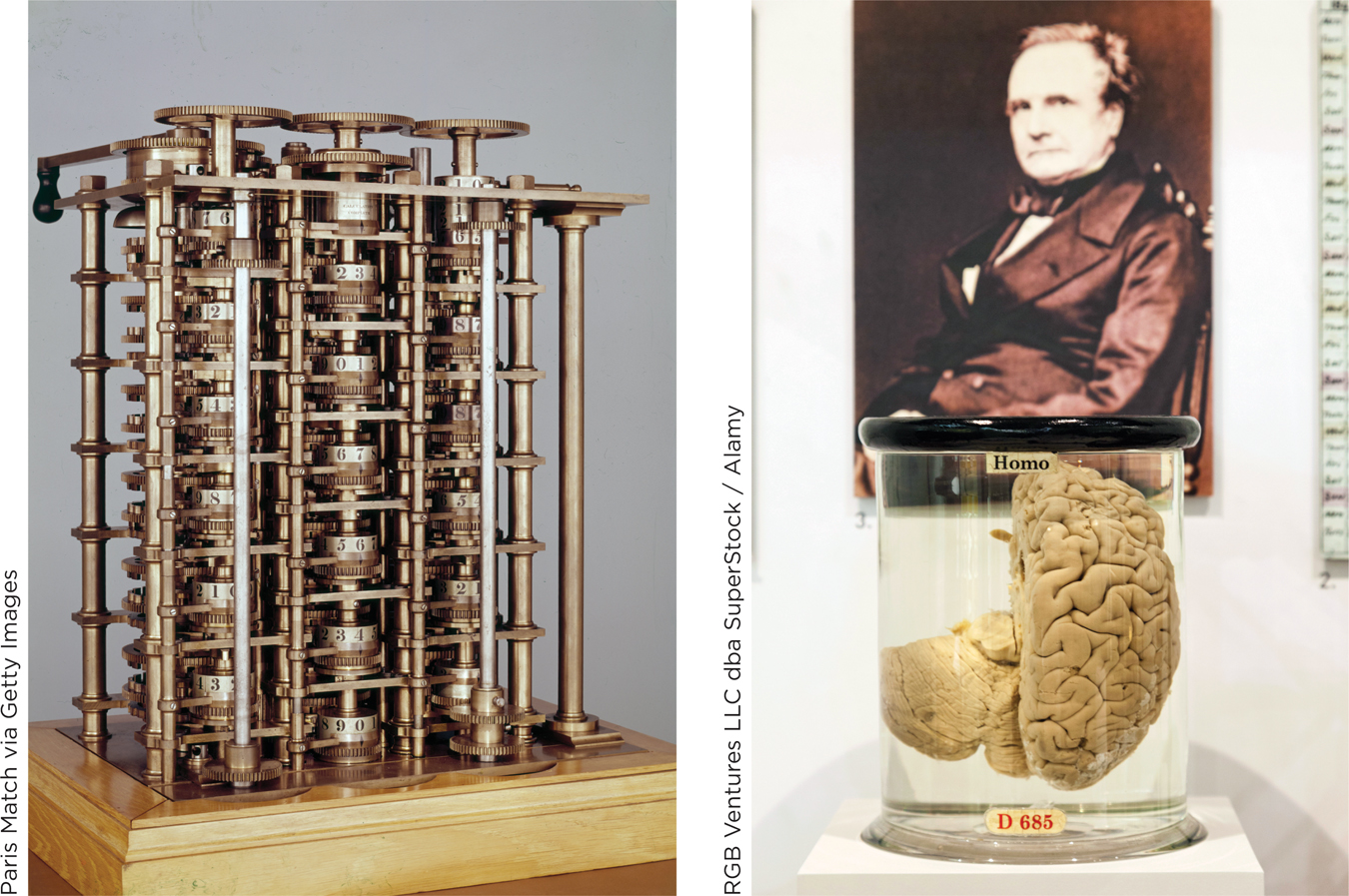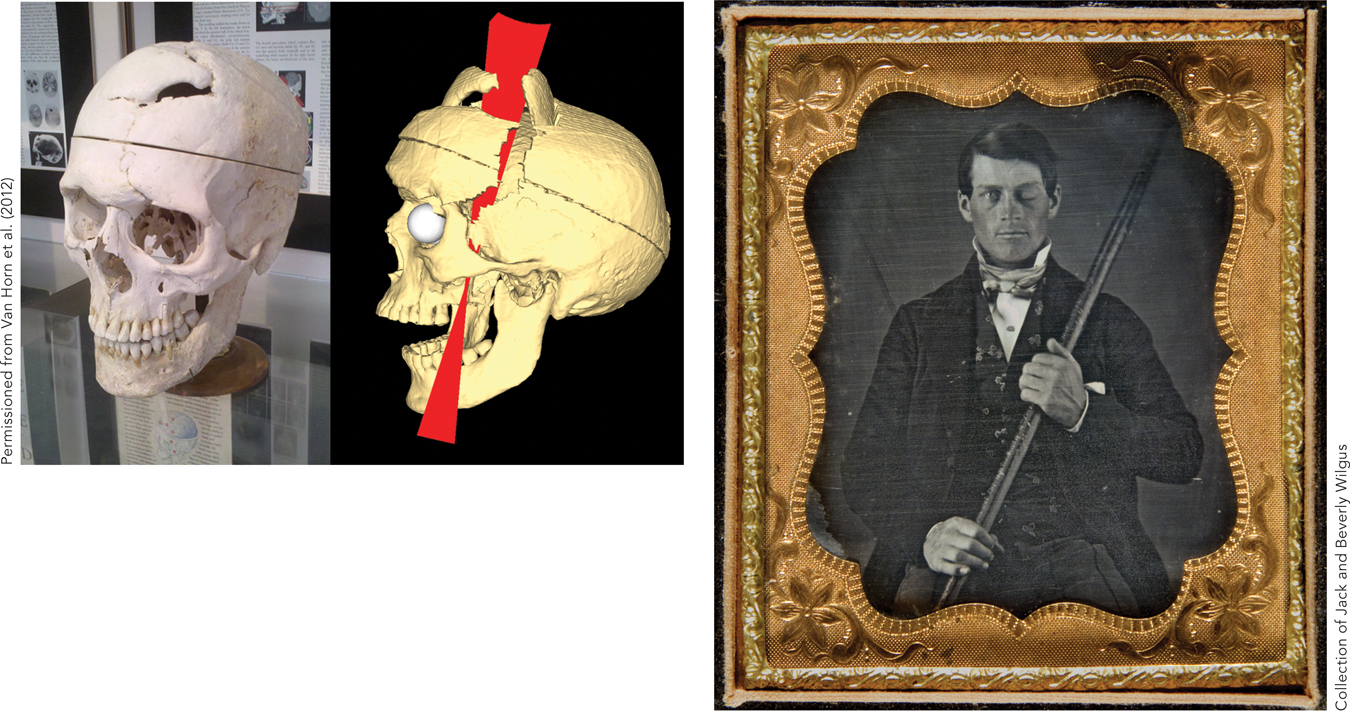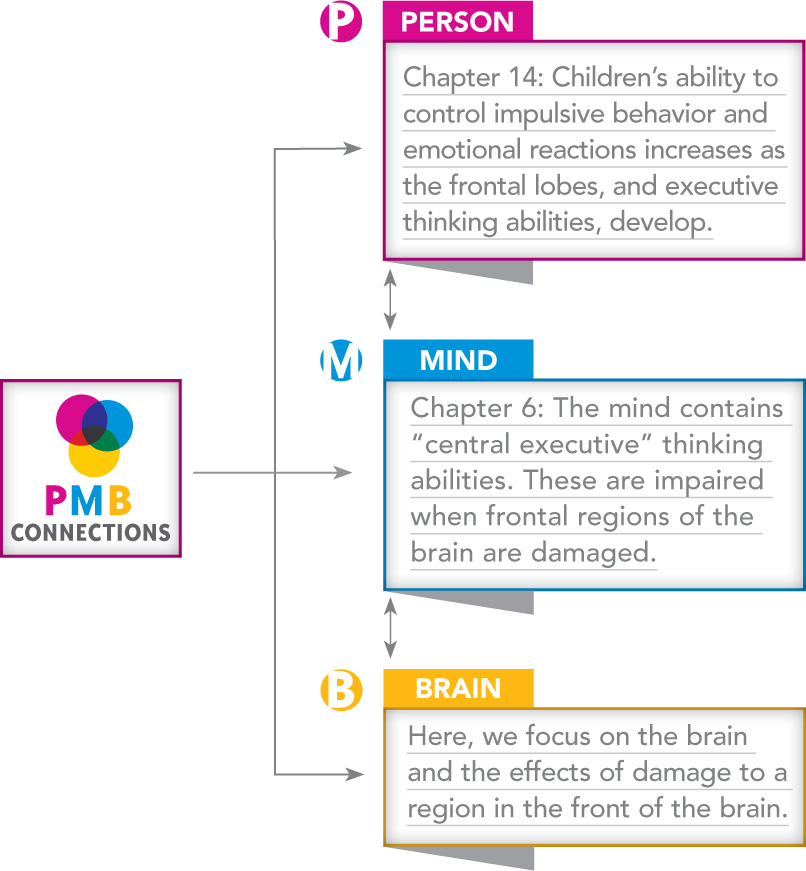3.1 Brain and Behavior: General Principles
The question “What is the brain like?” is not new. Scholars have speculated about it for thousands of years.

Ideas About the Brain Through the Ages
Preview Question
Question
 What analogies have been used to describe the brain through the ages?
What analogies have been used to describe the brain through the ages?
Throughout history, scholars contemplating the brain have proposed analogies (Hampden-
In ancient Rome, inventors devised pumps for propelling water into the city’s fountains. Romans who contemplated the brain judged that it, too, is a pump (Daugman, 2001). A physician, Galen, said that the brain controlled bodily movements by pumping “animal spirits” through the body’s nerves, which he claimed were like pipes (Vartanian, 1973).
By the start of the eighteenth century, European inventors had devised complex new machines (e.g., mechanical clocks), and Isaac Newton had explained that the universe functions according to physical laws, like a machine. Scholars of the eighteenth century judged that the brain and the body of which it is a part work like a machine. The analogy was made most explicit in a book by the French physician Julien La Mettrie, entitled L’homme Machine (“Man a Machine,” 1748; Wellman, 1992).
In the nineteenth century, physicists formulated laws of energy, inventors harnessed energy for industrial use, and Sigmund Freud said that the brain is an energy system (Breuer & Freud, 1895). According to Freud, different parts of the brain store mental energy and use it to power behavior. Just as too much pent-
up energy in a steam engine can cause mechanical problems, too much pent- up mental energy in the brain can cause psychological problems. Page 83 Babbage difference engine On the left is the first mechanical tool that seemed to “think”: the difference engine devised by the British mathematician Charles Babbage. It could compute solutions to complex mathematical formulas. The power of machines such as the difference engine inspired students of the brain to propose that the brain could be understood as a mechanical device—
Babbage difference engine On the left is the first mechanical tool that seemed to “think”: the difference engine devised by the British mathematician Charles Babbage. It could compute solutions to complex mathematical formulas. The power of machines such as the difference engine inspired students of the brain to propose that the brain could be understood as a mechanical device—a thinking machine in your head. On the right is the biological tool that Babbage used to invent the difference engine; Babbage’s own brain is preserved in a science museum in London. In the second half of the twentieth century, society’s new technological toy was the computer, and its favorite brain analogy was that—
you guessed it— the brain is like a computer. The physical brain was analogous to computer hardware and the mind’s beliefs and skills were akin to computer software (Simon, 1969). Interestingly, this analogy also worked in reverse: Computers, like brains or minds, are “machines who think” (McCorduck, 2004).
Our opening story introduced another analogy: The brain is like the Internet. The power of both comes from interconnections among large numbers of parts.
Each analogy—
WHAT DO YOU KNOW?…
Question 1
With changes in technology come changes in the used to describe the brain.
How the Brain Is Like a Tool
Preview Question
 What valuable points are highlighted by a brain-
What valuable points are highlighted by a brain-as- tool analogy?
The philosopher Rom Harré (2002, 2012) emphasizes that the brain is like a tool. People use their brains to do the jobs of everyday life. The brain/tool analogy highlights two valuable points:
You can use any tool for a variety of jobs, including those tasks for which it was not originally designed (Heyes, 2012). A screwdriver, for example, can serve not only as a screw turner, but also as a paint can opener, ice pick, or weapon. Similarly, although your brain was originally designed to solve problems encountered in the evolutionary past, you can use it to perform contemporary tasks—
reading, writing, driving— for which it was not designed originally. When you use a tool to perform a job, it is you—
not the tool— that is responsible for executing the job. You don’t say, “My shovel cleared the snow off the sidewalk.” You say that you did it, using a tool (the shovel). Similarly, you don’t say, “My hands typed my paper” or “My legs ran 2 miles in under 11 minutes.” You did those things, using biological tools— your hands and legs. Likewise, when solving a math problem, answering a trivia question, or learning a second language, it’s you— not your brain— that’s doing the problem solving, answering, or learning (Bennet & Hacker, 2003). You need your brain to do these jobs, but you, not your brain, did them.
The brain/tool analogy helps to avoid confusions that can occur when discussing the brain and people’s psychological experience. It is not the brain having the experiences; it’s the people. Although some writers talk about the “emotional brain” (Ecker, Ticic, & Hulley, 2012), “spiritual brain” (Beauregard & O’Leary, 2008), and “political brain” (Westen, 2007), the being who is emotional, spiritual, and political is not your brain; it’s you.
Why do you suppose people speak of the brain as if it’s the one that is emotional?
WHAT DO YOU KNOW?…
Question 2
The following statement is incorrect. Explain why: “The brain-as-tool analogy reminds us that it is the brain that performs tasks, not the person using the brain.”
How the Brain Is Like Muscle
Preview Question
 How have researchers demonstrated that the brain is like muscle?
How have researchers demonstrated that the brain is like muscle?
When you use a muscle repeatedly, it grows. As a result, you gain strength and are better able to perform physical tasks using that muscle.
Like a muscle, the brain also changes when you perform a task repeatedly. The changes make it easier for you to do that task in the future. Evidence of this comes from a study of juggling (Draganski et al., 2004).
Researchers invited to a lab 24 participants who did not know how to juggle and took pictures of their brains using neuroimaging methods (see Research Toolkit). Half the participants then spent three months learning how to juggle. The other half did not learn juggling. Afterward, brain images were taken again. By comparing the two sets of images, the researchers could see whether people’s brains had changed during the three-

They found that jugglers’ brains did change. The changes occurred in an area of the brain critical to processing visual motion, as you might expect because juggling requires close visual attention to multiple moving objects (Figure 3.1). This brain region expanded among people who learned how to juggle; there was a greater volume of brain cells in this area after juggling. No changes occurred in the brains of nonjugglers (Draganski et al., 2004).
Had you ever before considered the plasticity of your own brain?
The point of this research is not that juggling, per se, enhances the brain. It is more general: Experiences alter brain anatomy. Brain structures are not fixed and unchangeable. Instead, like muscle, they grow with experience. This feature of the brain is called plasticity, which is the brain’s capacity to change physically as a result of experience (Zatorre, Fields, & Johansen-
Note how plasticity makes the brain unlike a computer. If you run your favorite software application repeatedly, your computer’s hardware does not change. But if you yourself perform the same task repeatedly, the biological “hardware” of your brain does change.
WHAT DO YOU KNOW?…
Question 3
How is the concept of plasticity related to the idea that the brain is like muscle?
Different Parts of the Brain Do Different Things
Preview Question
 What can brain damage tell us about the structure and function of the brain?
What can brain damage tell us about the structure and function of the brain?
The human brain looks a bit like a cauliflower: roundish, off-
BRAIN DAMAGE EVIDENCE. How do we know that the brain is differentiated? Cases of brain damage provide convincing evidence.
Whether through injury or illness, people sometimes incur damage to one part of the brain. When this happens, there are, in principle, three possible outcomes for the mind:
No mental ability: The person won’t have any thoughts or feelings. It might be that every part of the brain must function normally in order to provide the capacity for thought.
All mental abilities are intact but impaired: The person will be able to think, but thinking will be less quick and intelligent. It might be that each part of the brain contributes equally to its overall speed and power.
Selective loss of specific mental abilities: Some thinking abilities will remain completely intact, but other abilities will be lost. This would indicate that the brain is differentiated and that the specific part that was damaged is needed for the specific mental ability that was lost.
What usually happens? Commonly it is #3. Brain damage often causes people to lose a specific mental ability. A case of brain damage from a century-
PHINEAS GAGE. The damaged brain was that of Phineas Gage, a railroad construction worker in Vermont (Damasio et al., 1994). Gage’s job was to supervise explosions designed to level land for laying track. Explosive force was supposed to go down into rock that was standing in the way of the railroad tracks. Unfortunately for Gage (but fortunately for science), an on-

What happened to Gage? As the Boston Post (September 13, 1848) reported, “The most singular circumstance connected with this affair is that he was alive … and in full possession of his reason.” Most of Gage’s mental abilities were intact. He could control the movements of his body, his speech was normal, and his memory was so good that he could even remember what happened to him in the accident. Gage seemed no less intelligent than before the accident occurred (Damasio et al., 1994).
Gage’s case, then, contradicts possibilities #1 and #2 above. Despite brain damage, he still could think, and just as quickly and intelligently as before.
Yet, in one specific way, Gage changed profoundly. Before the accident, he was well mannered. Afterward, he used profane language that offended friends and coworkers. Before, he had been industrious and responsible. After, he was so irresponsible that his employer had to fire him. Gage no longer could control his social behavior. He was unable to adhere to the rules, conventions, and responsibilities of society. His physician, John M. Harlow, summarized the change as follows:
Previous to his injury … he possessed a well-
—quoted in Macmillan (2000, pp. 92–
CONNECTING TO EXECUTIVE THINKING PROCESSES AND SELF-CONTROL

The case of Phineas Gage shows that even major damage to the brain may not eliminate a person’s ability to think, or even slow his or her thinking. Instead, brain damage is selective. It can cause people to lose one type of ability—
In summary, you’ve already learned a few lessons about the brain. It’s a biological tool that we use to perform the tasks of life. It’s a special kind of tool that becomes stronger the more it is used, like a muscle. It’s a complex tool, with lots of specialized parts. Finally, as you learned in this chapter’s opening story about a patient suffering from Capgras syndrome, even more complexity is involved: The various parts of the brain are highly interconnected. Even simple, everyday tasks require coordination among multiple brain regions.
Let’s now look at this remarkable biological tool in detail, to find out how it gets its jobs done.
WHAT DO YOU KNOW?…
Question 4
How might Phineas Gage have been affected by his accident if the parts of the brain were not specialized?